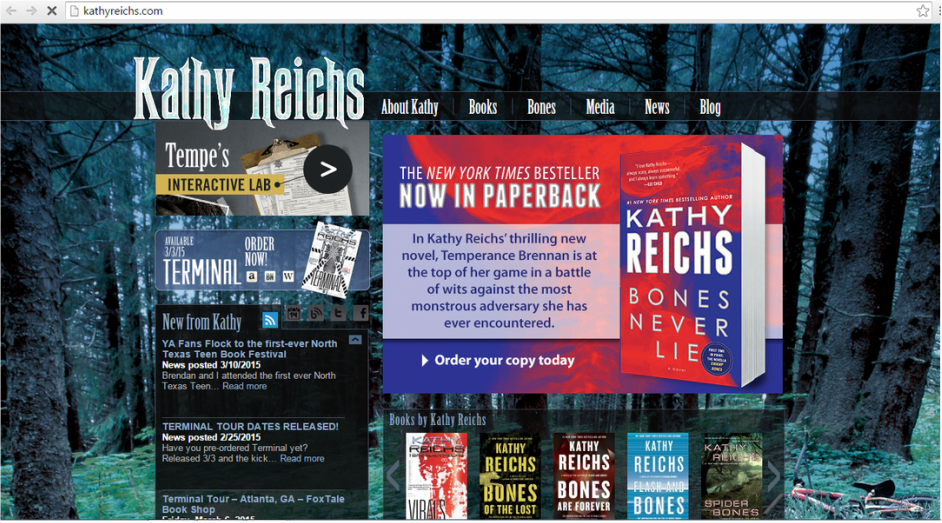
Print Ad Analysis
By examining print advertisements from different eras, it is possible to illuminate the ways in which the ads reflect the book and author, the anticipated audience for the book, and the economics, culture and society in which they are produced. Roland Marchand writes,“Advertisements depict and describe the material artifacts available for purchase at a given time. They reveal the state of technology, the current styles in clothing, furniture, and other products, and sometimes the relative prices commanded by various goods. Whereas archaeologists must deduce the probable social uses of the artifacts they unearth, and then interpret from them the economic and social structures of the society, advertisements provide us with ample guidelines to the social functions (or at least the suggested uses) of various products. They can supply this information about a society without depicting either a person or a social setting, merely by displaying and describing the products themselves.” – Advertisements as Social Tableaux
Tell My Horse : Voodoo Life in Haiti and Jamaica (1938) Zora Neale Hurston
Tell My Horse, by African American author and anthropologist Zora Neale Hurston, was published in 1938 by Lippincott. The result of field work funded by a Guggenheim fellowship she performed in the Caribbean, Tell My Horse is an unusual work. The title is the English translation of a common Haitian Creole saying, “Parlay cheval ou”. According to Hurston biographer Valerie Boyd, using this phrase enabled the speaker to assume the stance of Guede, a god who would possess a human like a rider mounts a horse. Guede could say anything, so by pretending to be him, the speaker was free to say anything to anyone (p.320). The subject matter of the book is, “…an ambitious, flawed mix of reportage, folklore, political commentary, and travelogue” (p.321).
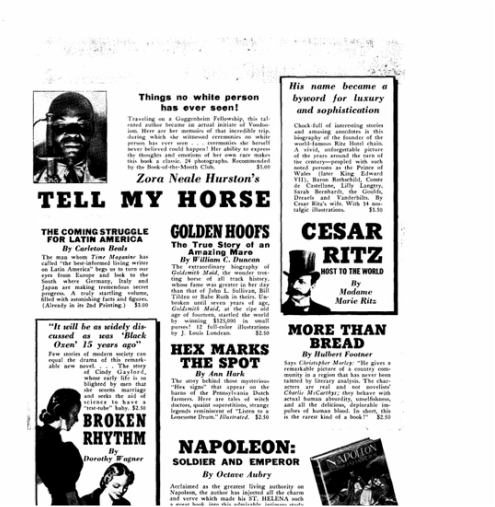
I found two advertisements for Hurston’s work with the American title. The ad feature the image of a solemn and serious looking Black man, looking down and holding a sword appeared in the Saturday Review of Literature along with a review on October 15, 1938. A British ad featuring this image appeared in the Sunday Times in London, on May 9, 1939 with the British title Voodoo Gods. The Saturday Review of Literature was first published in 1924. Aimed at middle-class readers, it featured articles on literature, reviews and literary criticism. It positioned itself as a tastemaker and authority on “important books”. The review of Hurston’s Tell My Horse is placed next to a feature of similar length on Ernest Hemingway’s The Fifth Column and the First Forty- Nine.
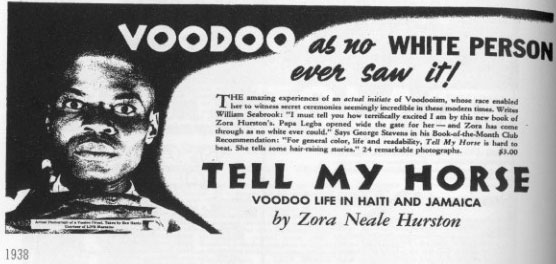
Analysis
The appearance of a review and ad in this location suggests that Hurston’s work was aimed at serious readers of literature. The tone however, is sensational. “Things No White Person Has Ever Seen” trumpets the header of the ad from the Saturday Review. Clearly, the readership is understood to be white and middle class. Hurston’s race is a selling point. Hurston is touted as a spokeswoman for her entire “race” with the line, “Her ability to express the thoughts and emotions of her own race make this book a classic. 24 photographs.” This is reductionist in multiple ways. The fact that Hurston is an American and not Haitian is irrelevant compared to her blackness, which overrides any class privilege her citizenship and educational background provides. All Africans and African Americans are presumed to have a group mind and emotional landscape, the same despite any regional or class differences. This singular experience is one that Hurston can voice, according to the text of the ad, literally. Race is the “ultimate trope of difference” (Higginbotham p.253).
Evelyn Brooks Higginbotham wrote of this phenomenon in “The Metalanguage of Race” stating, “Race not only tends to subsume other sets of social relations, namely, gender and class, but it blurs and disguises, suppresses and negates its own complex interplay with the very social relations it envelops. It precludes unity within the same gender group but often appears to solidify people of opposing economic classes. Whether race is textually omitted or textually privileged, its totalizing effect in obscuring class and gender remains” (p. 255).
The white reader’s power to gaze upon and consume the “Other” is emphasized. Hurston’s insider whistle blower role is underscored by the advertisement’s emphasis on her experience as an initiate of voodoo rites. White middle class readers are invited then to peek into hidden mysterious rites performed by “Others”. The experiences Hurston relates are described as incredible and unbelievable while the author’s authority is authenticated by the funds provided by the Guggenheim Fellowship that funded her research. Bizarrely, this title is listed as a “Book of the Month Club” book. Priced at $3.00, it costs twenty-five cents more than Hemingway’s Fifth Column.
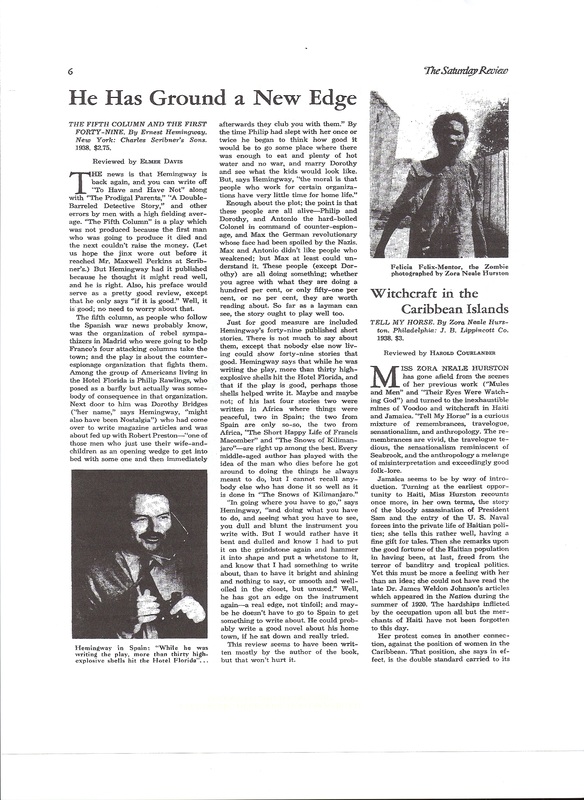
The second American ad for this title features similar language and imagery to the first. While the first ad in SR (as it was known) showed a Black man staring blankly like a zombie holding a sword, the second features a wide wild and wide eyed Black man staring at the viewer blankly. Hurston’s experience in Haiti is described as “amazing”. Again, the header, which use different font styles to effect, highlights the sensational, “VOODOO as No WHITE person ever saw it! The font used for the word voodoo evokes primitiveness. The line itself is reminiscent of a tabloid headline. One interesting difference between this ad and the first American ad in the SR is that a testimonial is included from William Seabrook. He says, “I must tell you how terrifically excited I am…” Seabrook wrote Jungle Ways (1930) among other books. He was a journalist, traveler, Occultist associated with the Lost Generation era and is noted for having claimed to have participated in cannibalism. This blurb pumps up the sensational rhetoric of the ad text and hypes the more sensational elements of the book.
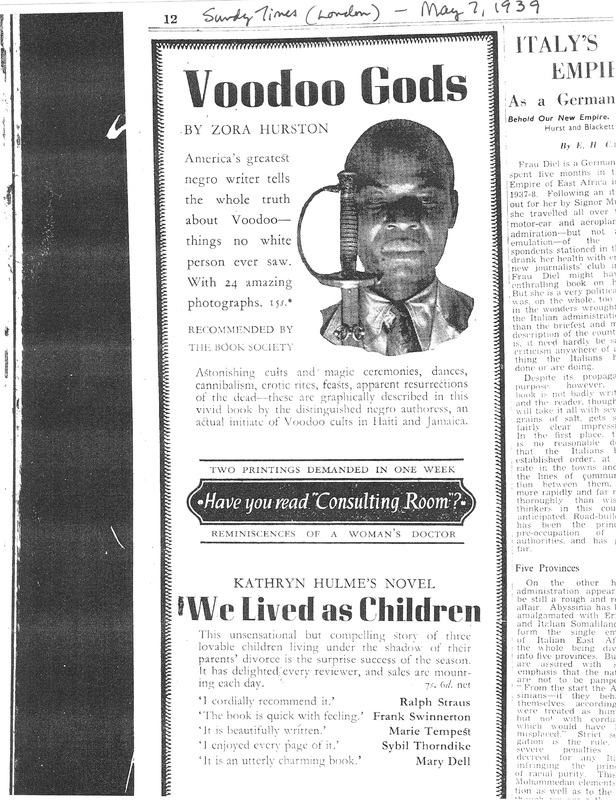
Boyd relates that Tell My Horse did not appeal to Depression era Americans, but sold so “briskly” in England that “the publisher earned back Hurston’s $500 advance after only a week (p.322).” The English ad also appeared in a highly reputable and influential venue. The text of this ad states what is implied in the American ad with code words of “ceremonies and rites” when it claims that, “Astonishing cults and magic ceremonies, dances, cannibalism, erotic rites, feasts, resurrection of the dead- these are graphically described in this vivid book by distinguished negro authoress, an actual initiate of Voodoo cults in Haiti and Jamaica.” Hurston is also promoted to “America’s greatest Negro writer.” Like the American version, it is “Recommended by the Book Society.”
The explicit language of the British ad taps into the not so subtle subtext of the American ads, evoking images of savagery, violence, threatening sexuality, danger, boundary breaking behaviors. Higgingotham writing about Western culture’s construction of black sexuality says that these perceptions “…perpetuated an enormous division between black people and white people on the “scale of humanity”: carnality as opposed to intellect and/or spirit; savagery as opposed to civilization; deviance as opposed to normality; promiscuity as opposed to purity; passion as opposed to passionlessness” (263). Interestingly, in the Saturday Review that features a review of Hurston’s book and Hemingway’s side by side, a photograph of Hemingway is included in the copy, but Hurston’s book is illustrated with a photo from the book of a black Haitian woman “Felicity Felix” a supposed zombie, not a picture of the author. Though she did later appear on the cover art of another edition.
Hurston’s intention was not “reify” racial stereotypes or to intrude upon the private religious experiences of Caribbean and American Creole Voodoo practioners. Hurston valued and privileged Black experiences, drawing heavily upon upbringing in Eatonville Florida, an independent incorporated Black town. Supremely confident in herself and proud of her Blackness, by writing in her unique voice of the lives of African Americans, she placed them at the center of their own stories, not at the periphery or margins as victims or sideshows for White viewers. The vogue for Black writers that helped catapult her into the American literary consciousness was waning in America as her career wound down in the forties and fifties. A star of the Harlem Renaissance of the twenties and thirties, Hurston is more popular than ever today, thanks to a resurgence in interest in her work spurred by Alice Walker. She is considered to have influenced award winning African American authors Walker and Toni Morrison, among others.
Lives, Crimes, and Confessions of the Assassins. Last moments of the convicts in their cells–scenes at the scaffold and the execution. Truthful, wild and fearfully exciting. (1865) by Dr. L.L. Stevens
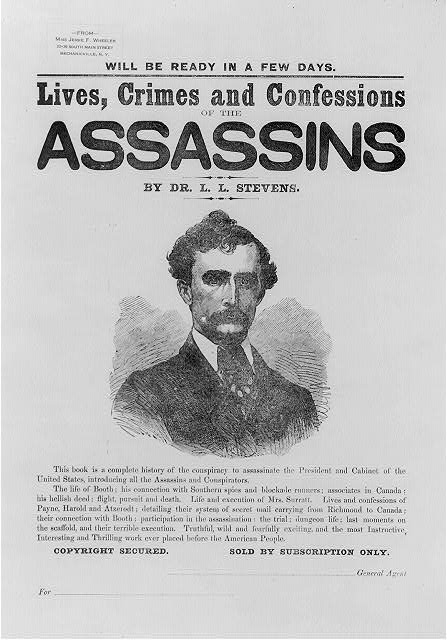
Purporting to be a “complete history of the consipiracy to assasinate the President and Cabinet of the United States, Introducing all the Assassins and Conspiritors” this book is advertised with a broadside detailing the subject. As common in the nineteeth century, details of the book contents are provided. Broadsides were printed on one sheet of large paper and were used to advertise a wide array of events and products and to share information. This broadside is held by the Library of Congress. The MARC record describes it as a “broadside” and as “an advertisement for a book, with bust of Booth.” The image is listed as a “woodcut”.
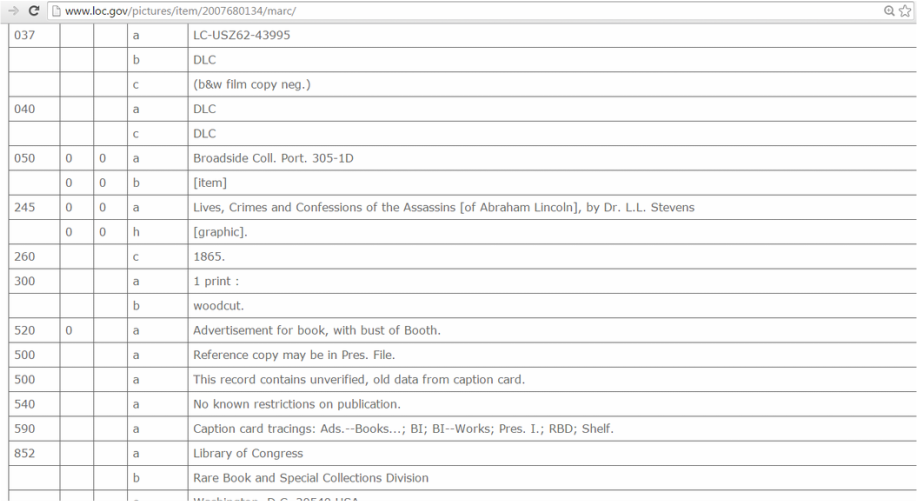
Ian Brabner, in a blog posted on American Booksellers Association of America website “The New Antinquarian” writes that, “American broadsides fall under the broader category of historical ephemera—printed items created and intended only for temporary, fleeting use. These ephemeral artifacts documented the beliefs, activities, and concerns of a very specific time and place in American history.” In this case, this book published the year the American Civil war ended seeks to provide information to readers on the “hellish deed” of President Abraham Lincoln’s assassination. Brabner would classify this broadside as “Visual Americana”- “American history in images.”
Ad Analysis
Broadsides might be displayed in public to inform readers, draw in customers and advertise a product. It is possible that this broadside was placed in a shop window or affixed to wall indoors or outdoors in a public place. A drawing of John Wilkes Booth is used to draw the eye of the viewer. No doubt the picture of the notorious assassin (some might say “celebrity”) caught the attention of the viewer. In a way, the design of this advertisement evokes a “most wanted poster”. Given the “seismic impact” Lincoln’s murder had on the country, there was a great deal of public curiosity and need for information on the subject (Holzer). This broadside capitalized on this need and onthe most sustained emotion that characterized the response to Abraham Lincoln’s assassination… burning curiosity. “
Subscription Only
Interestingly, this book was “by subscription only” a method Mark Twain employed to sell his books. Subscription services sold books before they were published. An agent might hawk a book in a workplace, or go door to door. This broadsheet provides a blank line at the bottom that offers a place for the agent to sign his or her name. Prospective buyers of this title used the detailed description in the broadside to determine if the material appealed to them. Hamlin Hill (1964) writing about Mark Twain (1964) discovered instructions for successful sales agents:
“Knowing How. You have been appointed one of our agents, and we take it for granted that you intend to succeed. This is right. But you must also know how. We can show you how if you will let us. Will you do this? If so, and you will PRACTICE what you learn, we unhesitatingly promise you success.
Canvassing includes five progressive steps taken in the following natural order:
First:–Thorough preparation.
Second:–Securing influence.
Third:–Gaining a hearing.
Fourth:–Creating a desire.
Fifth:–Taking the order.”
Agents canvassed their territories, used the power of peer pressure (neighbor’s signatures on orders) and delivered books to the homes of subscribers.
The Third Life of Grange Copeland (1970) by Alice Walker

Alice Walker is a celebrated African American author, poet, activist and noted feminist intellectual. She won the Pulitzer Prize in 1983 for The Color Purple. Cochran (2001) summarizes Walker’s first novel, The Third Life of Grange Copeland as, “Walker’s feminist-ethnic stance on the Job story” (p.97). Walker is widely credited with the resurgence of interest in Harlem Renaissance author Zora Neal Hurston. Like Hurston, Walker grew up in the South and drew upon her identity as a Black woman to create stories that placed the experience of African Americans at the center of the narrative. Butler (1993) observes that, “Walker’s sense of herself as both a black and Southern writer, then, enables her to participate in a literary tradition containing a richness of vision which she finds missing in the mainstream of American literature”(p.79). Also, like Hurston, Walker placed an emphasis on positive elements of African American experiences. Walker, “describes the South where black people worked as a community, were not ashamed of who they were, and where she got to know the inner-strength of black people that she writes about in much of her fictional writings” (p.296).
Ad Analysis
This ad appeared in the New York Times (America’s paper of record) on September 17, 1970. It shares marked similarities with the promotion of Tell My Horse by Hurston, but with modern twists and important differences.
To place this ad in the context of its time period, in 1970, the Civil Rights movement’s greatest accomplishments were in the past and many of its leader’s had been slain. Racial tensions were high. The Vietnam War raged and the Equal Rights Amendment would not be passed to the states for ratification (which failed) until 1972.
This ad introduces Walker to a discerning and affluent audience. The ad foregrounds Walker’s portrait. Her physicality takes center stage. Her hair is natural or styled in an Afro, a political statement in 1970. It signifies her affirmation that “Black is Beautiful” and rejection of white beauty standards. The confidence she has in herself is reminiscent of Hurston, but the prominence of her portrait is more like the previously discussed Hemingway author portrait. Her pose and unsmiling facial express signify that she is serious and her work is important. Immediately beneath her photograph is a testimonial from African American author Julius Lester. It says, “A sharecropper’s daughter tells “as in no novel I can recall, the history of a people”. Interestingly, like Hurston in the Tell My Horse ad Walker’s identity is a key component of her storytelling ability and her Blackness and rural origins are part of the promotion of the book, underscoring her authenticity. In this case however, it is another person of color, not an anonymous copywriter who makes the claim that she offers unique insight to the story she tells and the connotations are different. This is in contrast to the spectacle element of Hurston’s Voodoo book’s promotion. However, like Hurston, Walker is positioned as an authority and spokesperson for the black community, “an entire people” according to Lester. Because of the injustices that her novel depicts, this testimonial and other blurb quotes have an association with slave narratives that sought to expose the exploitation and injustice of slavery and sound the alarm bells for social justice movement. A word cloud of the blurbs in this advertisement would include the words: true, honest, tragic, black, humanity, power, experiences, and poet.
Interestingly, who months after this ad appeared, on November 23, 1970, Toni Morrison’s The Bluest Eye was also advertised in the Times. Like Walker, Morrison sports an afro is positioned as a truth teller.
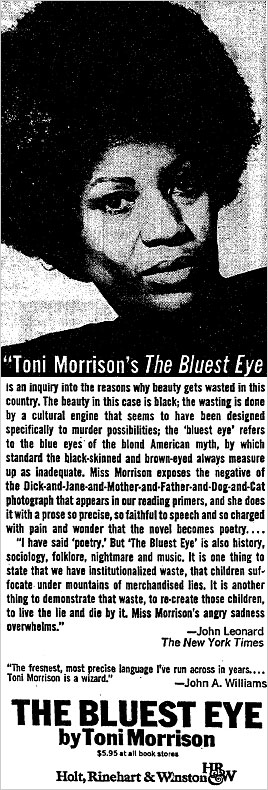
David Sedaris: The Brand
Instead of examining a single print ad for David Sedaris, it is more appropriate to examine a 21st century author in the context of the digital age. Sedaris’ official website is aimed at astute and savvy digital natives and immigrants who can afford a computer, smartphone and internet access. That is to say, readers who mostly likely middle class and are attuned to highly visual and interactive advertising. Not only does the site assume that the author’s fans are comfortable using the computer and the internet, it assumes they use it frequently, if not constantly. By accessing this site, readers can check the author’s tour schedule, follow links to other information on him, read up on his works, subscribe to his newsletter, follow the author on Facebook and contact the author. In the biography section, Sedaris’ photograph appears along with biographical information about his life. Blurbs that might be found on a book jacket or in a traditional print ad tout critical acclaim his works have garnered and position the author as America’s preeminent humorist. The style of the site is sophisticated, modern and charming which is also true of the author, so it reflects his style and the content of his writing.
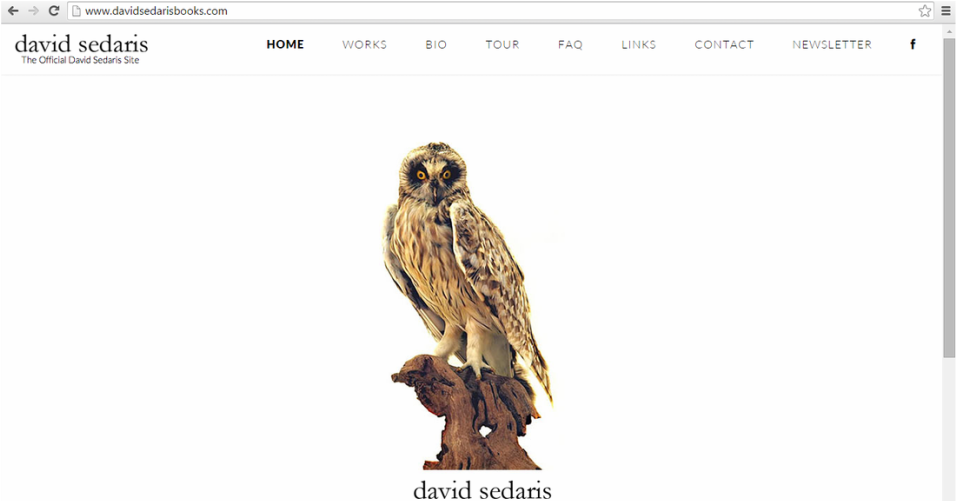
The home page does not feature a photograph of the author as might be expected. Instead, a photograph of an enigmatic owl against a bare white background stares at the viewer. (Different owls are featured on each page of the site as well.) This is an in-joke for readers who may recall a humorous essay in which Sedaris considers buying a stuffed owl as a gift for his partner Hugh. This image reinforces the assumption that site visitors are already fans who are well versed in his work.
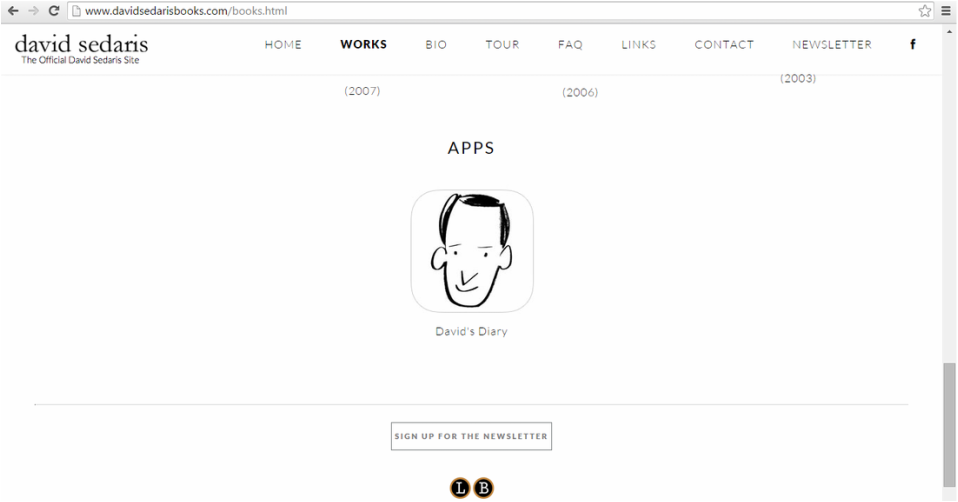
There is also an app titled, “David’s Diary” which is not free. Sedaris’ essays are based on his life, so as part of his writing routine he records entries into his diary every day. Part of the author’s fame is based on his NPR appearances and on public readings of his work, so these films fit well with his brand as they invite readers to share in his life. To give potential app buyers a taste of the app’s offerings, there is an example of a short amusing film narrated by Sedaris based on a diary entry.
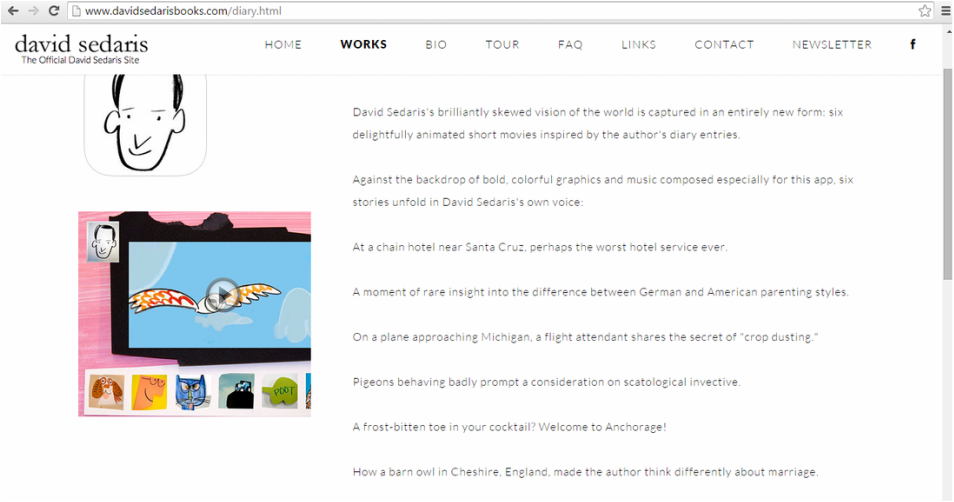
-
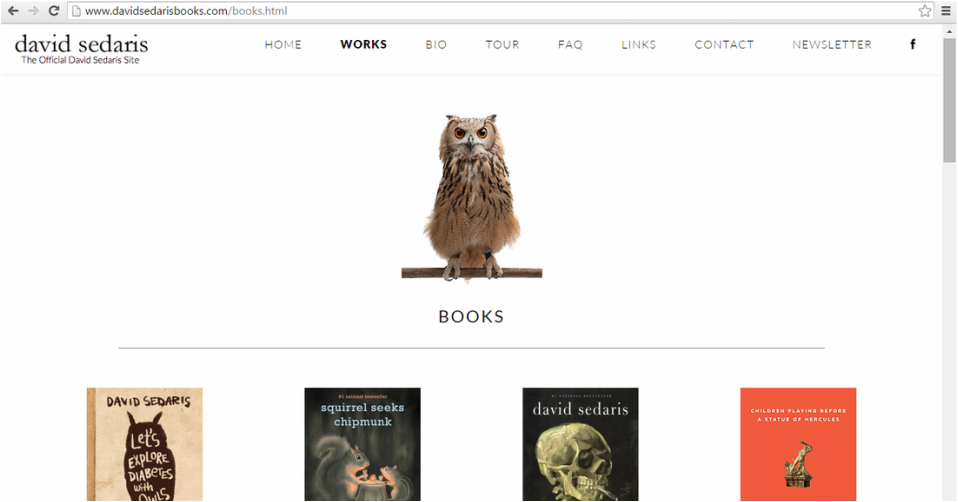
References
Arts Beat Blog. (2007, June 11). Book Ads: The Golden Age, 1962-73. The New York Times.
Excitement and Sensation on a Postage Stamp.Dutch Book Advertisements as a Go-Between in the Eighteenth Century
Boyd, Valerie. Wrapped in Rainbows: The Life of Zora Neale Hurston. New York: Scribner.
Bowerman, P. (2008, December 18). What Does “Bestseller” Really Mean? Seybold Report Analyzing Publishing Technologies. pp.8-14.
Boyd, ValerieWrapped in Rainbows: The Life of Zora Neale Hurston. New York: Scribner.
Butler, R.J. (1993) Alice Walker’s vision of the South in the Third Life of Grange Copeland. African American Review. 27(2) 195.
Cochran, K. (2001). “When the Lessons Hurt.” The Third Life of Grange Copeland as Job an Allegory. Southern Literary Journal. 34(1), 79.Courlander, H. (1938, October 15). Witchcraft in the Caribbean Islands: Tell My Horse by Zora Neale Hurston. The Saturday Review of Literature. pp. 6-7.
Douglas, L and Alexander, G. (2005) Lawrence and Alex’s Excellent Publishing Adventure! Publishing Research Quarterly. (Summer). pp. 16-18.
Gael, P. (2012, March).The Origins of the Book Review in England, 1663–1749 The Library. 13(1). pp.63-89.
Higginbotham, E.B. (1992). African-American Women’s History and the Metalanguage of Race. Signs. 17 (2). pp.251-274.
Holzer, H. (2015). What the Newspapers Said When Lincoln Was Killed. Smithsonian, 45(11)1.
Linderbaum, P. (2010, December). Publisher’s Booklists in Late Seventeenth-Century London. 11(4). pp.382-404.
Millier, L.J. (2000). The Best-Seller List as Marketing Tool and Historical Fiction. Book History (3). pp.286-304)Ohmann, R. (1983). The Shaping of a Cannon: U.S. Fiction, 1960-1975. Critical inquiry. 10(1) pp.199-223.
Perrottet (2011, April 29). How Writers Build the Brand. Sunday Book Review. http://www.nytimes.com/2011/05/01/books/review/how-writers-build-the-brand.html?_r=0
Reid, C. (2012, May 12) Can Big Data Fix Book Marketing? Publisher’s Weekly. pp.54-62.
Robinson, C.C. (2009) The Evolution of Alice Walker. Women’s Studies, 38(3), 293-311. Doi10.1080/004797870902724679
SaveSave
SaveSave

0 comments on “Book Advertisements”